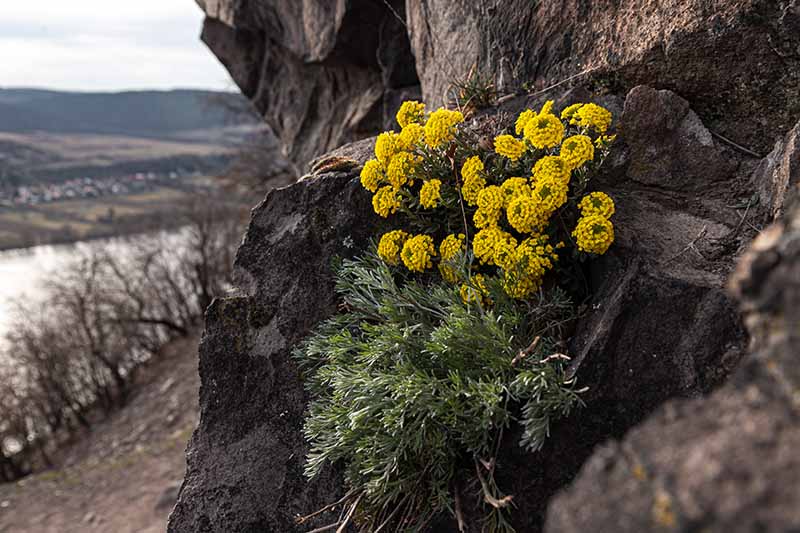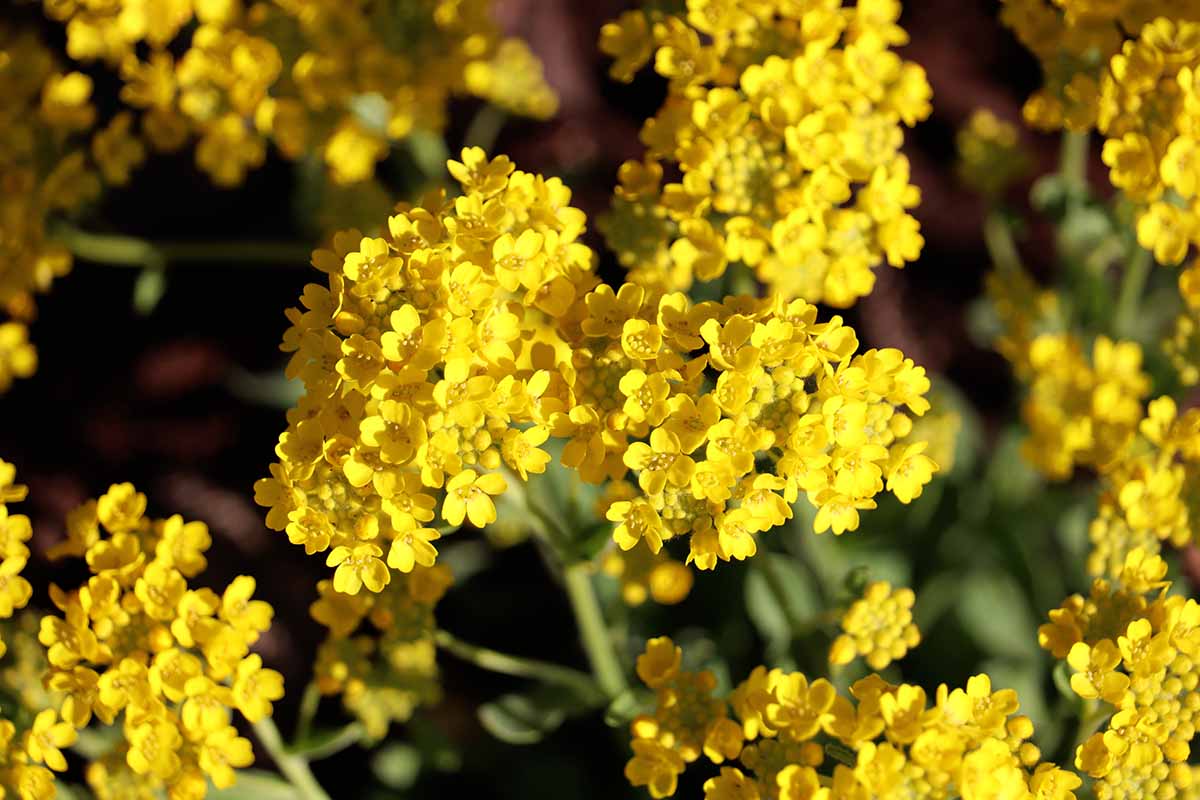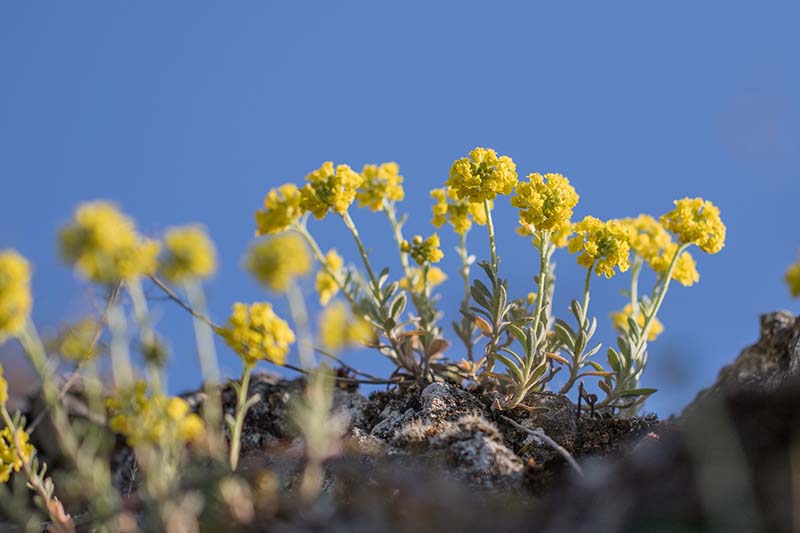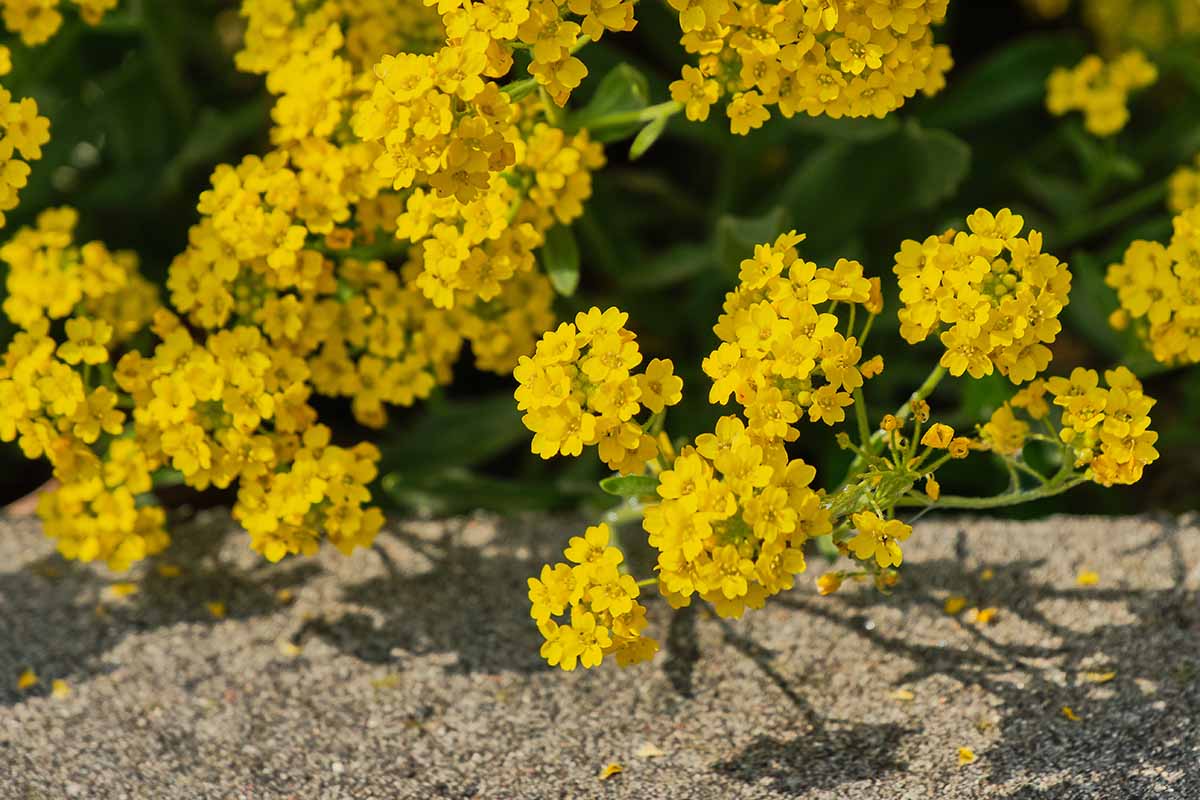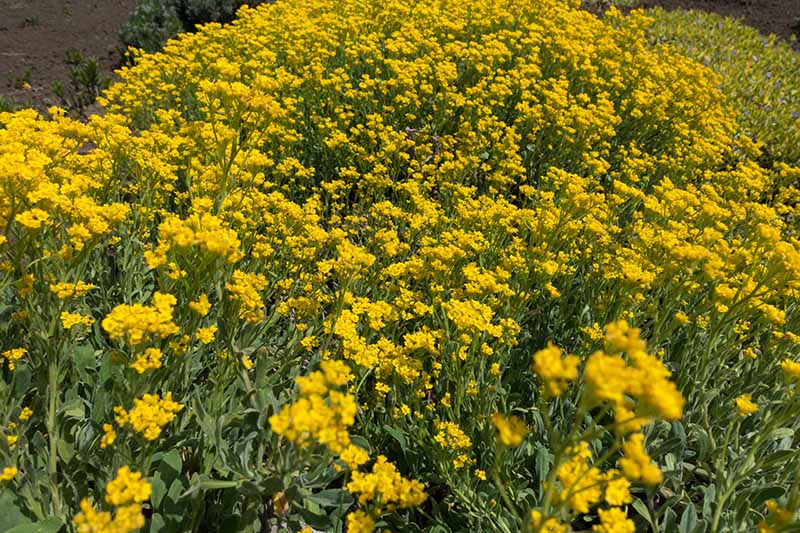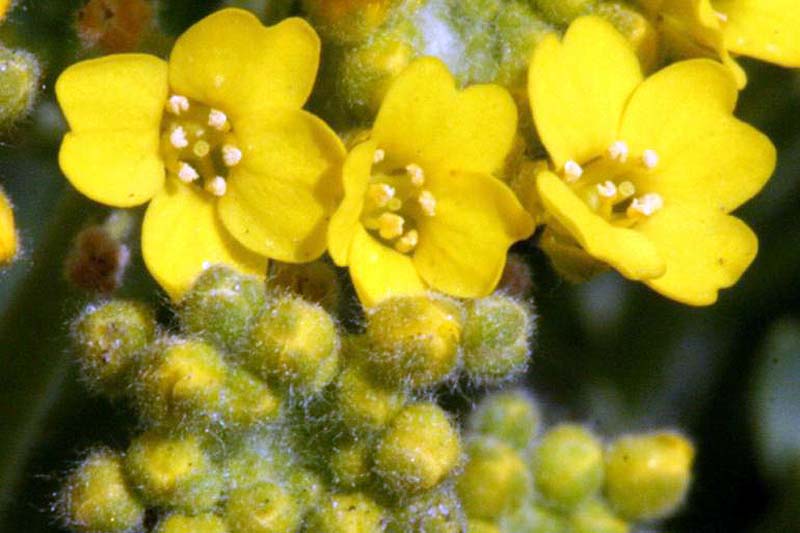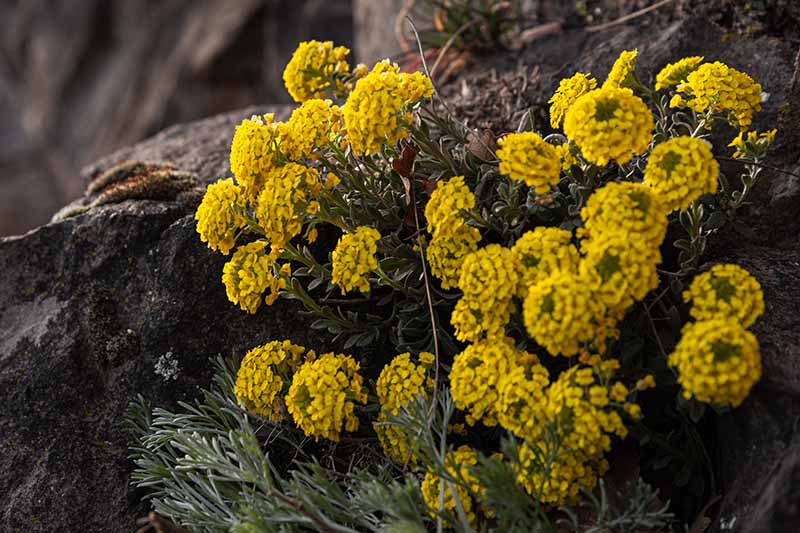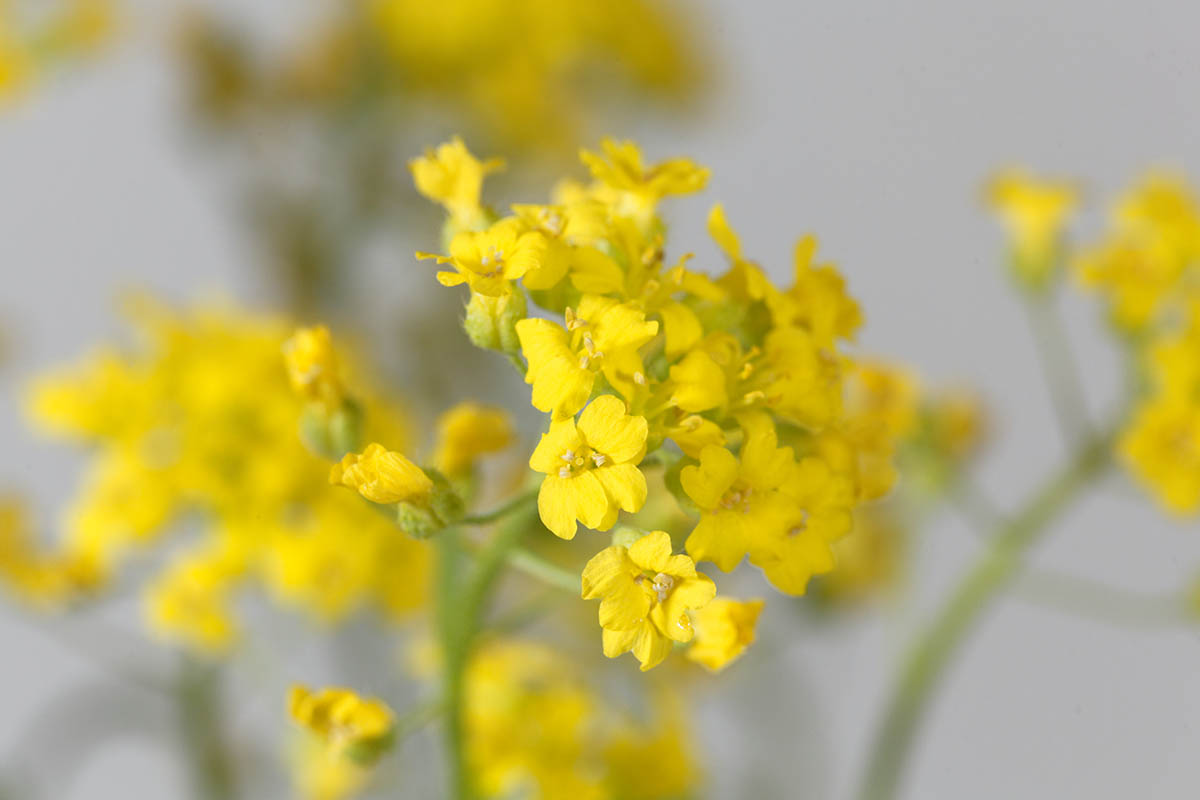My traveling companions and I took a train up the mountains and then walked down, enjoying the sparse yet lush landscape. Wildflowers abounded in hues of yellow, purple, blue, and white. The yellow tufts of alyssum were especially intriguing to me. I had never noticed how much the flowers resemble bolted broccoli. We link to vendors to help you find relevant products. If you buy from one of our links, we may earn a commission. Out of all the plants in the world, I believe A. montanum has one of the best nicknames ever: mountain madwort. It may be a member of the same family as broccoli, but mountain madwort excels as a low-growing, perennial ground cover. If you live in Zones 3 through 9, you definitely want to consider adding it to your yard or garden. Let’s dig in! Here’s what we’ll cover:
What Is Mountain Alyssum?
A low-growing, mat-forming perennial, A. montanum is native to the rocky hills and mountains of France, Switzerland, Germany, Spain, and other regions in Europe. It has also naturalized in the United Kingdom. The plant is nontoxic to kids and pets, making it a fantastic ground cover choice for anyone with dogs or children under foot. Mountain alyssum thrives in elevations up to 8,000 feet. It grows well in rocky, low-water areas – like the cracks and crevices in the mountains it’s named for. The plant grows four to eight inches tall and spreads 12 to 18 inches at maturity, making it an ideal choice for a ground cover. Gardeners can expect it to reach its full size within two to five years. A perennial plant, it bears small, hairy, green-gray leaves all year long. In the spring, the plant blossoms with clusters of small, sweet-smelling, bright yellow flowers that continue blooming into early summer. Mountain alyssum is often conflated with another type of plant in the Brassicaceae family known commonly as basket of gold that produces tiny yellow flowers and flourishes in the mountains. It used to be part of the Alyssum genus and was called Alyssum saxatilis. Now, however, A. saxatilis is in its own genus, Aurinia, although Alyssum saxatilis remains a synonym. The name change occurred in 1814, according to a 1966 article published in the Bulletin of Popular Information of the Arnold Arboretum at Harvard University, when the French botanist, M. Desvaux, realized that A. saxatilis was distinct from A. montanum and created a new genus, Aurinia. Later, other botanists slid Aurinia back into Alyssum as a subgenus before moving it back out as its own standalone genus, which is part of the reason why there’s still confusion about which plant is which. One way to tell plants in the Aurinia and Alyssum genera apart is this: Aurinia plants have basal rosettes with tufted leaves that typically grow to between three and six inches in length. The basal rosettes on plants in the Alyssum genus do not have tufts and only grow up to one inch long.
Propagation
The best methods of propagation are rooting softwood cuttings or sowing seeds. We will cover both methods below, as well as discussing how to transplant seedlings out into the garden.
From Seed
If you wish to start seeds indoors, you can do so six to eight weeks before your area’s average last frost date. Select seed-starting containers with drainage holes and fill them with potting mix. Moisten the soil with a spray bottle before sowing. Drop one seed into each cell and push it into the soil just slightly; mountain madwort needs light to germinate, so you don’t want to cover the seeds completely. Set the container next to a window that receives bright, direct sunlight for at least six hours a day, or place it under a grow light turned on for eight to 10 hours a day. It takes approximately seven to 21 days for seeds to germinate, and it’s important to keep the soil lightly moist throughout this period. Covering them with a humidity tray can help to trap in that moisture. Check the soil daily to make sure it’s moist enough, and if it’s not, water with a spray bottle to provide moisture without displacing the seeds. The ideal temperature for germination is between 64 and 70°F, so if your home tends to run cold, you may want to use a heat mat. After germination occurs, remove the humidity dome and heat mat, if you used one. Keep a grow light trained on the fledgling plants for eight to 10 hours every day, or make sure the tray stays in bright sunlight shining through a window for at least six hours daily. If you wish to sow seeds outdoors, the best time to do so is two weeks after the average last frost date. Select an area that receives six to eight hours of sun every day. Sow seeds about six to eight inches apart, pressing them down just barely. Remember: these little seeds need light to germinate. Keep the seeds moist until germination, using the misting nozzle on the hose to avoid disturbing them.
From Cuttings
Whether you know a friend with mountain alyssum or you have an existing plant you’d like to propagate, the best time to take a cutting is in the early summer, when new growth is soft and supple. Another way to check whether or not your cutting has grown roots is to gently tug on the stem. If it resists, this is a sign that the plant has begun to establish a root system. Using a pair of gardening shears, snip several four- to six-inch cuttings off the plant. Make sure there are plenty of leaves on each cutting. Trim the leaves off the bottom inch or two of each stem and dip it in rooting gel, like Olivia’s Cloning Gel®, available in two-, four-, and eight-ounce containers from Arbico Organics. Olivia’s Cloning Gel Place each cutting in its cup, burying it one to two inches deep. Water the soil thoroughly. Set the pots indoors on a windowsill that receives bright, indirect sunlight, and cover it with a humidity dome to hold in moisture. Keep the soil moist but not soggy, and you should begin to see roots developing through the clear plastic within six to eight weeks.
Transplanting
If you decide to simply purchase a young plant from a nursery, or the cutting or seedling you nurtured has two to three sets of new, true leaves, here’s how to transplant it to the garden. First, you’ll want to wait until the weather is warm enough to keep the plants happy and healthy. Once your area’s average last frost date is at least two weeks behind you, start setting the plant outside for an hour the first day, then two hours the next day, and so on, increasing the time gradually until it’s spending most of its day outdoors. Find a spot in your yard or garden that receives at least six, preferably eight, hours of direct sun every day. Amend the soil with a cup of well-rotted manure or compost and dig a hole that’s the same size as the root ball. Carefully remove the plant from its container. You may need to loosen the soil away from the edge of the pot using a butter knife. Slide the root ball into the hole and backfill with soil. Water the area thoroughly, and then plant the next madwort six to eight inches away if you want a solid ground cover, or 12 to 16 inches apart if not.
How to Grow
Mountain alyssum readily self-seeds, so you can expect seeds to develop, drop to the ground to overwinter in the soil, and pop up the following spring! Once you’ve put your plant in the ground, fertilize it with standard plant food. If you sowed seeds outdoors, you’ll want to add fertilizer about four weeks after germination. I like to go organic when feeding my plants, so I prefer Dr. Earth’s Pure Gold Organic and Natural 2-2-2 NPK flower and plant fertilizer, available in three-pound bags from the Home Depot. Dr. Earth Pure Gold Fertilizer You’ll also want to fertilize the plant after the first set of flowers has bloomed and died back. First, you’ll deadhead the spent blooms as described below, and then work the fertilizer into the soil and water your plant thoroughly. This will help to encourage another set of blooms in the late summer or early fall. After that set of flowers is finished, you can allow the plants to go to seed. When it comes to hydration, mountain madwort likes to stay slightly moist, but not wet. Water your plants deeply once a week. Every few days, check the soil moisture level by poking your finger about one inch down. If the soil feels dry, it’s time to give your plants another drink. During the winter, reduce watering to once every two weeks or so. If the soil freezes where you live, stop watering once the earth freezes and then resume watering after any snow or ice melts and is absorbed into the soil. In the spring, give your plants another round of fertilizer so they can shore up the nutrients they need for a fabulous flowering season.
Growing Tips
Plant in a location with full sun and well-draining soil.Keep the soil moist but not soggy.Apply fertilizer twice a year: once in the spring and again in the summer.
Pruning and Maintenance
There’s not a lot you need to do to maintain your mountain alyssum. The most important thing is to deadhead the spent flowers after the first bloom. You can also lightly cut the plant back, snipping about an inch off the tops – including those spent flowers. This can be quicker than cutting off numerous clusters of flowers one by one. And, since mountain alyssum tends to get leggy, trimming it back can help the plant stay lower to the ground. By removing all the old blooms, the plant will get the message that you want more blooms, and it’ll put its energy into reblooming into another field of sunshine in the late summer or fall. If you don’t want it to multiply, you’ll also need to cut back spent flowers after the second bloom before they go to seed.
Cultivars to Select
It can be difficult to find plants for sale, but the effort is more than worth it. When you’re searching, keep an eye out for these A. montanum cultivars.
Luna
Are you looking for a variety that will bloom a little early, cheering you up as winter winds down? Then ‘Luna’ is the cultivar you need. This plant bears foliage that’s a little more green than gray, and it blooms with brilliant yellow blossoms from mid-spring to early summer. ‘Luna’ grows four to six inches tall with a spread of 12 to 18 inches.
Managing Pests and Disease
Mountain alyssum tends to fend off most pests and diseases with ease, and it’s not likely to cause you trouble in the garden. Like ‘Luna,’ ‘Mountain Gold’ grows four to six inches tall with a spread of 12 to 18 inches, but unlike ‘Luna,’ its foliage has more silver than green. ‘Mountain Gold’
Tekara
Developed in 2014 by Jelitto Seeds, ‘Tekara’ was bred to be the ideal ground cover, forming nicely uniform, flat cushions, and its racemes are flatter and less rounded than those of its species siblings. ‘Tekara’ blooms in March and April and reaches just under four inches in height at maturity with a spread of about 12 inches. Like ‘Mountain Gold,’ ‘Tekara’ has silvery leaves. The two main issues to keep an eye out for are aphids and root rot. Aphids may attack simply because they’re in the area and they have an indiscriminate love of, well, devouring plants. If you notice the small green, red, or grayish insects clustering on the stems, take action by spraying a neem-oil-based solution onto the affected plants once every three to four days until the infestation subsides. As for root rot, all you need to do to avoid this common problem is ensure that your plant does not sit in soggy soil. Remember, this plant thrives in rocky, dry, well-draining areas, and it’s better to err on the side of too dry than too moist.
Best Uses
Mountain alyssum makes a perfect ground cover, it’s true, but it can also add flair to your home in other ways. If your driveway has cracks or unsightly edges, why not plant it in the cracks and crevices, adding charm to these outdoor spaces in an unexpected way? In the same vein, you can plant mountain alyssum in rock gardens or between stepping stones, or in dry problem spaces that just need a bit of brightening. A. montanum also makes a lovely addition to window boxes and flower gardens, where it can serve as the cheerful anchor for all sorts of other beauties, such as violets, lavender, and roses, to name a few. Also, keep in mind that this plant attracts pollinators. Try planting it among your fruit trees, tomato plants, and melons to draw in the bees and butterflies. Have you ever grown this type of alyssum? We’d love to hear how you make use of this sweet plant in the comments below. In the meantime, check out these articles on other flowery members of the Brassicaceae family:
Grow Sweet Alyssum for a Long Season of Fragrant BloomsHow to Grow Virginia Stock, a Cordial Summer VisitorHow to Grow and Care for Dame’s Rocket

